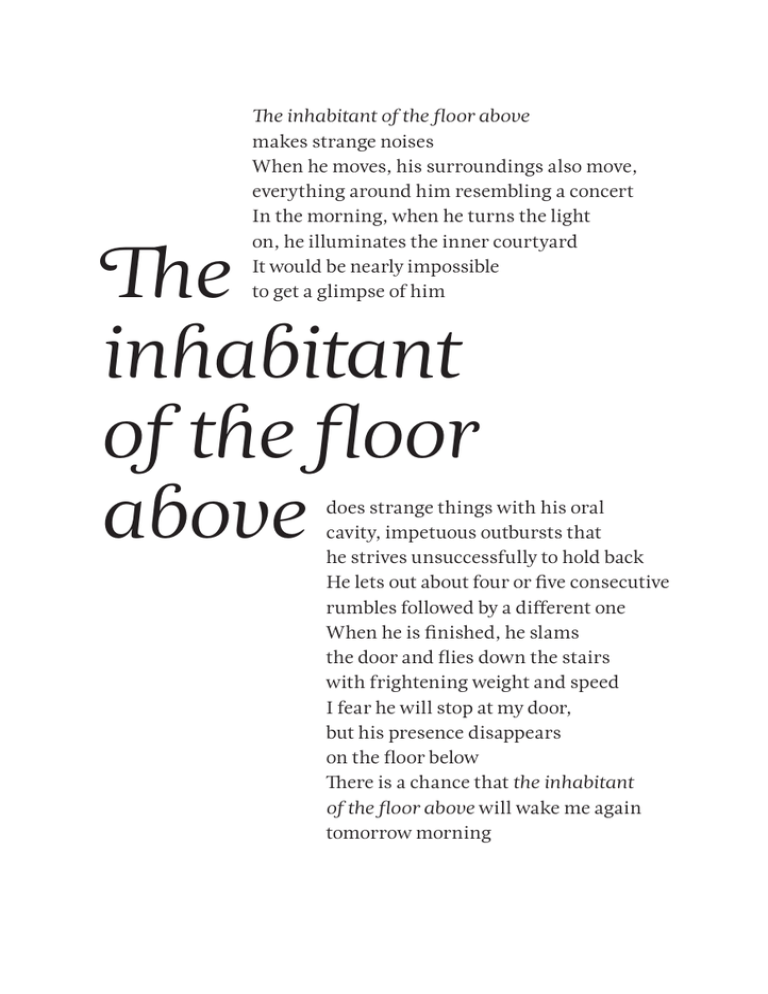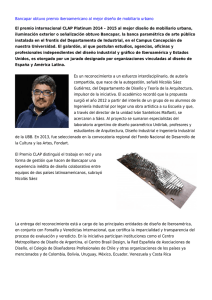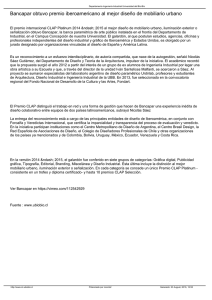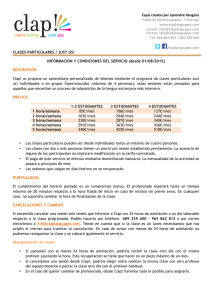The inhabitant of the floor above
Anuncio

The inhabitant of the floor above makes strange noises When he moves, his surroundings also move, everything around him resembling a concert In the morning, when he turns the light on, he illuminates the inner courtyard It would be nearly impossible to get a glimpse of him The inhabitant of the floor above does strange things with his oral cavity, impetuous outbursts that he strives unsuccessfully to hold back He lets out about four or five consecutive rumbles followed by a different one When he is finished, he slams the door and flies down the stairs with frightening weight and speed I fear he will stop at my door, but his presence disappears on the floor below There is a chance that the inhabitant of the floor above will wake me again tomorrow morning 1 2 El habitante del piso de arriba hace ruidos extraños Cuando se desplaza, todo lo que le rodea se mueve, su entorno parece ofrecerle un concierto El habitante del piso de arriba enciende la luz por la mañana, ilumina el patio interior Apuesto que costaría entreverle El habitante del piso de arriba hace cosas extrañas con el cavidad oral, un acceso que trata de aguantar Emite unos cuatro o cinco tonos y otro diferente Cuando está listo, da un portazo y baja las escaleras con una velocidad y una pesadez espantosa Temo que se pare a mi puerta, pero su presencia se desvanece en el piso de abajo Quizás el habitante del piso de arriba me despertará otra vez mañana VERONICA VALENTINI 3 4 A hora hacía ya más de un año que no oía al vecino de arriba, y fue ayer cuando lo entendí todo, leyendo el periódico. ¡Que sorpresa ver al raro Vincenzo en la portada! Contaban minuciosamente sus hazañas: ¡el robo sensacional! El 21 de Agosto de 1911, un día de limpieza, cuando el museo estaba cerrado al público, Vincenzo Peruggia, un empleado del Museo del Louvre, sacó la inapreciable Mona Lisa de su marco dorado y se fue. Puesto que Leonardo da Vinci pintó a la sonriente dama sobre madera en lugar de tela, Peruggia no pudo enrollarla y huir. Sin embargo, se las arregló para hacerla desaparecer en su apartamento, donde permaneció en el falso fondo de un baúl durante dos años. Después que el furor de la prensa hubo pasado, intentó vender la pintura en su Italia nativa por 95.000 dólares. Los funcionarios italianos lo arrestaron inmediatamente y devolvieron la obra maestra, de 300 años, a Francia y sin ningún rasguño. En su juicio en Florencia, Peruggia convenció al tribunal que su acto había sido inspirado por el patriotismo y que su única motivación había consistido en devolver el retrato a la tierra de su creador. Por esto, recibió la sentencia, relativamente suave de sólo un año y 15 días de cárcel. En Paris ha sido designado “enemigo número uno” del arte. Un ladrón famoso… ¡Y yo sin saber que tenía la Gioconda a escasos tres metros de distancia! ORIOL VILANOVA 5 I t had been more than one year since I had last heard the upstairs neighbor. But yesterday, as I was reading the newspaper, I understood everything. What a surprise to see this strange Vincenzo on the front page! His achievement was meticulously reported as ‘the sensational robbery’! On 21th of August 1911, a cleaning day, when the museum was closed to the public, Vincenzo Peruggia, an employee at the Louvre Museum, took the invaluable Mona Lisa out of its golden frame and left. As Leonardo da Vinci painted the smiling lady on wood instead of canvas, Peruggia couldn’t roll it and run away. However, he sorted it out and made it disappear in his flat, where it remained hidden at a chest false bottom for two years. After the fury of the press was over, he tried to sell the painting in his native Italy for 95.000 dollars. The Italian police immediately arrested him and returned the 300-year-old masterwork to France without a single scratch. In Florence, during his appearance in court, Peruggia convinced the judges that his act had been inspired by patriotism and that his unique motivation had consisted in bringing the portrait back to its creator’s homeland. That’s why he was generously sentenced to one year and 15 days of prison. In Paris, he’s been named the art ‘arch-enemy’. A famous thief… And I was there, unaware to be only 3 meters away from La Gioconda! ORIOL VILANOVA 6 Un guion basado en el cuento "Un Creyente" de George Loring Frost Publicado en Memorabilia (1923) reparto narrador hombre 1 hombre 2 narrador [Con voz profunda y grave] Al caer de la tarde, dos desconocidos se encuentran en los oscuros corredores de una galería de cuadros. [Espera unos segundos y con énfasis dice mirando al público que le mira] Con un ligero escalofrío, uno de ellos dijo: [Mira al Hombre 1 como si le pasara el turno] hombre 1 – Este lugar es siniestro. [Mirando para ambos lados y para arriba. Espera 4 segundos] ¿Usted cree en fantasmas? [Mirando a Hombre 2 temblando un poco y cogiéndose los brazos] hombre 2 – Yo no [Mira a Hombre 1 despreocupado con las manos en los bolsillos de su pantalón] narrador Respondió el otro hombre 2 – ¿Y usted? hombre 1 – Yo sí [Sale corriendo de la sala al mismo tiempo que Hombre 2 hace un gesto de sorpresa y desconcierto] narrador Dijo el primero y desapareció. TAMARA KUSELMAN Script based upon the short story "A Believer" by George Loring Frost Published in Memorabilia (1923) 7 cast narrator man 1 man 2 narrator [With a deep voice] At sunset, two strangers meet in the dark hallways of an art gallery. [Waits a few seconds and looking at the audience says with emphasis] With a soft chill, one of them said: [Looks at Man 1 indicating is his turn to speak] man 1 – This place is creepy. [Looking to both sides and upwards. He waits 4 seconds] Do you believe in ghosts? [Looking at Man 2 shivering a little and stroking his own arms] man 2 – I don't [Looks at Man 1 nonchalant with his hands inside his trousers pockets] narrator Said the other man man 2 – And you? man 1 – I do [He runs out of the room at the same time that Man 2 shows surprise and bewilderment] narrator Said the first man and vanished. TAMARA KUSELMAN 8 No hay nadie abajo. He escuchado sonidos que no vienen de otro mundo sino que podrían fácilmente atribuirse a los estiramientos y contracciones pausados de la casa. El juego de una baldosa, la lenta inclinación y caída de una maceta durante un año y que se concluye en un instante. Les sombras mueven y juegan con la luz en el resquicio de la puerta. Hay alguien invisible abajo Algunos preguntarían, hay alguien allí, y la criada quizás respondería, no, no hay nadie. A veces, una casa se ve ocupada por gente invisible que van y vienen - En el Upper Eastside, por ejemplo, esta gente entra por atrás llevados por ascensores invisibles para quitarles discretamente el polvo a las estanterías, pintar las paredes, arreglar el fregadero. Aún más abajo, en el vientre de la ciudad, gente están haciendo estallar túneles, sin ruido. Mientras la ciudad se estira y crece, necesita tuberías, cables, trenes. Veo gente en el metro cada día, hecha polvo, maloliente, que se pone a gritar a la cara de los ejecutivos sólo para confirmarse luego en su propia invisibilidad. Para ellos, la casa no es hogareña. La casa se ha construido en un pendiente y no dejan de deslizar hacia abajo, agarrándose a cualquier cosa a su alcance que les pueda detener. Pero en cada momento, un brazo cansado desiste otra vez, silenciosamente. SRESHTA RIT PREMNATH There is no one downstairs 9 I have heard sounds that are not otherworldly and could just as easily be attributed to the slow stretching and contracting of the house. The shifting of a tile, the slow tilt and fall of a flowerpot over the course of a year that ends in an instant. Shadows shift and move the light beneath the door. There is someone who is invisible downstairs. One may ask, is there anyone home, and the house help may reply, no, there is no one. Sometimes a house is occupied by invisible people who come and go – In the Upper Eastside, for instance, these people enter through the back carried by invisible elevators to quietly dust shelves, paint walls, fix sinks. Even further below, in the belly of this city, people are exploding tunnels noiselessly. As this city stretches and grows it needs plumbing, cables, trains. I see people in the subway everyday, tattered, stinking, who shout into the faces of corporate executives only to further confirm their own invisibility. For them this home is unhomely. The house has settled itself at a tilt and they keep slipping down and down, grabbing onto anything within reach for support. But every now and again a tired arm silently lets go. SRESHTA RIT PREMNATH 10 THE FIVE LETTER GHOST JULIA GOROSTIDI 11 The five letter Ghost has followed me again today. I stood up early this morning, woken up by my neighbour using his Glimakra’s floor loom. I open the window for fresh air. Aquí está de nuevo, la verde, cruzando la calle. Lo lleva en sans sérif hoy, no como de costumbre. Al moverse, deja aparecer la andorrana. Allí, como siempre, probably selling the Teo Cabanel’s one or other A’s cosmetics. I make some coffee and turn on the radio. Oh please John, shut up if it’s meaningless. Si le pide pelar la Yuca, me pongo a llorar. I turn it off and go check my emails. Nothing, spam and newsletters and her, again. Amazone’s new Book “Dime quién soy”, I need to get out of this appartment, no me puedo quedar en esta casita de Mariscal. I bet it would be difficult not to meet her again today. Lo primero, olvidate del metro: te acuerdas de la L4? I’ll just go walking. One street and two and three and again, Portet. I need a drink, anything but a Grappa. I enter the next mexican bar. Una Margarita podría ayudar. I look around and feel trapped. Aquí están, por todas partes, en la pared, en la televisión, en el menú. Martha, Raúl, la Santa… hasta Enrique Guzman me las esta escupiendo por los altavoces. Una y dos y tres, bien untadas con nata doble. I fear that another one may come up on TV. I don’t want to eat, pray or love, I have to go. Doy un portazo y me voy corriendo hasta el mar, cerrando los ojos para no ver los carteles de los suyos. Finally… nothing but the horizon, this thin quiet line. But something goes wrong, a strange feeling of anxiety seizes me. I play the Pink Floyd song in my head. Where is she? La del Mar, la hermana de Don Carlos que se desliza con gracia pese a su carga. Perhaps I’ll speak to one of them1 tomorrow. 1. www.oneofthem.me JULIA GOROSTIDI 12 Maison/Raison D’Être (I - VI) I “Suelo Sucio Caja De Telepizza Tiene Sobras II Media Tarde Es Un Tiempo De Eterna Soledad III Pasa El Gran Sol Por Los Pequeños Huecos De Las Grandes Persianas No Tengo Hambre Pero Tengo Sed Solo En Casa Es Una Película Círculos De Luz Reposan En Mi Pose Camino Lento En Una Espiral Hasta Caer Suena Una Tele Mujeres Y Hombres Y Viceversa No He Apagado En Cinco Meses La Luz Y No He Pagado La Caja De Pizza Es Una Almohada Aquellos Maravillosos Años Endesa Agudiza Va Después De Esto Mi Crisis Personal Con Mi Mano Un Borde De La Pizza Saco De La Caja Acerco Oreja A La Fría Pared Esperando Algo Sigo Creyendo En Algún Otro Mundo Sin Creencias Pizza Cruda Recuerda Un Pasado Mejor Escucho Mucho Menos Que Antes Creo Que Voy Al Mercadona” RYAN RIVADENEYRA 13 IV “You Never Ever Speak Such Spanish When Listened To V You’re Not Thirsty But Still Watching Movies Makes You Hungry VI We’re Connected In Many Many Ways At This Moment But I Hear You Even When You’re Not Here Blue Velvet Film Red Velvet Cake First And Foremost A Wi-Fi Network Sharing Secrets Isn’t As Good As It Sounds It Takes Time To Make A Sandwich For One You Love Internet Out I Shout Hysterically You Stay Calm So Listen Up To The Lowest Noise Only I Know Best Of Tomorrow’s Another Day What Sandwich You Think Of You Say Today You’re In The Other Room I Make Sandwiches Listening To Me That Resemble Stonehenge Calling Our Company I Quietly Listen To In The Other Room I Come On Down And Ask What’s Up The Phone Not Working I Restart The Router Our Connection Failed” And Its People Tiny Monoliths Groovy Movie Stars RYAN RIVADENEYRA 14 el hombre [...] de las tinieblas. [...] produjo [...] ruidos estridentes del mundo [...] Cuando Louis llegó [...] la superficie del desastre [...] se desplegó [...] Su auditorio rugía de risa. [...] El mayor [...] desde hace muchos años, [...] alumbró su mundo interior [...] había supuesto que [...] ¿le resultaría imposible, [...] a primera vista [...] con [...] “El ojo [...] había ideado ejercicios especiales [...] Así, [...] el [...] ingreso [...] se detuvo [...] extendía [...] unas dieciocho [...] o [...] veinte [...] incidentes [...] había alcanzado la perfección de su forma [...] Tan pronto como pudo hacerlo, [...] perturbó [...] apabulló [...] y [...] el suelo cedía bajo sus pies [...] Tenía [...] una creciente agonía [...] No podía verlo. Pero sabía que existía, podía sentirlo [...] posible y probablemente [...] el espíritu invisible [...] pasara a verlo a la noche, [...] por segunda vez —Autobiografía de una idea, Louis H. Sullivan DANIEL JACOBY 15 the [...] monstrous [...] man [...] let loose [...] strident noises of the world [...] When Louis came [...] the vast area of disaster, [...] spread out [...] His audience roared, [...] The Major [...] for many years, [...] lit up his inner [...] world [...] he had assumed to [...] never [...] see at a glance [...] with [...] "The eye [...] he, [...] had devised special exercises [...] So [...] the [...] entrance [...] came to a stop [...] lay between [...] eighteen [...] and [...] twenty [...] incident [...] He [...] had attained to its perfection of form [...] As soon as it could be done, [...] stride [...] shock [...] and [...] the earth leave him, [...] He had [...] a cumulating agony [...] He could not see. But he knew it was there, he could feel it [...] perhaps and probably [...] the invisible spirit [...] was [...] to [...] come over that evening [...] again —The Autobiography of an Idea, Louis H. Sullivan DANIEL JACOBY 16 na tarde de sábado del frío invierno de 2011 me encargaron escribir un relato ficticio que debía estar inspirado en un cuento sobre un vecino fastidioso. Hablaba de las molestias causadas al narrador por el inquilino del apartamento en el piso superior, que movía muebles y realizaba otras actividades ruidosas que ahora no recuerdo. Fue una alegre (al menos alegre para mi) coincidencia puesto que en aquel momento yo acababa de mudarme a un ático y, arriba, claro, no tenía vecinos. Otra casualidad curiosa me sucedió la primavera del año anterior mientras estaba realizando un proyecto en una sala de arte de la ciudad de Barcelona. Mi investigación en ese momento estaba centrada en el análisis de estrategias de desplazamiento de la atención y mi caso de estudio era una grabación de un partido de tenis que había sido emitido por televisión unos meses antes. Las sillas de la oficina de aquella sala de exposiciones eran revisiones de las B32 y B64 (que es como la B32 pero con apoyabrazos), unos de los primeros modelos en cantilever diseñados por Marcel Breuer a finales de los años 20. Por una serie de circunstancias que no corresponde explicar aquí, esta silla se popularizó con el nombre de Cesca, que también es el nombre de la novia del tenista Rafa Nadal, cuya fotografía en biquini aparecía en el póster de la exposición, puesto que me parecía un buen ejemplo de esos elementos de distracción a los que quería referirme. Al final, para recordar esta bonita casualidad, y de forma más o menos ilícita, conseguí una de esas sillas Cesca para mi apartamento. GABRIEL PÉRICAS 17 n a Saturday afternoon during the cold winter of the year 2011, they asked me to write a fictitious tale that had to be inspired by a story about a tiresome neighbor. This was about the troubles caused to the narrator by the tenant of the flat upstairs, who used to move the furniture and had some other noisy activities that I don’t remember right now. It was a cheerful coincidence (at least, cheerful for me) as I had just moved at that time to a top-floor apartment and upstairs, of course, there was no neighbor. Another curious coincidence happened to me during the spring of the year before while I was working on a project for an art room in the city of Barcelona. My research at that time was focusing on the analyze of shifts in attention strategies and my case study was the recording of a tennis match that had been broadcasted on television some months before. The office chairs of this exhibition room were the re-edition of the B32 and B64 (which is the armrest version of the B32), one of the very first cantilever models designed by Marcel Breuer at the end of the 1920s. Due to a series of circumstances which explanation is not worthwhile here, this chair became popular as Cesca, which is also the name of tennis man Rafael Nadal’s girlfriend, whose photography with a bikini appeared on the poster of the exhibition, as I thought it was a good example of those elements of distraction I wanted to refer to. In the end, to recall this nice coincidence and in a more or less illicit way, I got one of those Cesca chairs for my flat. GABRIEL PÉRICAS 18 Action taking place in alpha Parisian theater at the ending XIX century – âge d’or – of the Claque*. An audience is composed of different kinds of man; similar people cannot bring an audience into existence. The Inhabitant of the Floor Above cast I: elder O: cadet I & O are sitting next to each other and facing the audience. Their exact positions are kept secret. I [Getting up and looking down] We whistle! O [Same game] It’s below! I Muscles... at work! O [Vigorous applause] Clap ! Clap ! Clap ! I [Sitting down - as well as O] It’s over! [Another whistle] O No! I [Standing up - as well as O] It’s above! I [Applause with all his might - as well as O] Bravo! Bravo! Bravo! Clap! Clap! Clap! Clap! Clap! Clap! Clap! Clap! Clap! *Slap AUDREY COTTIN 19 O Whistler demolished! I [Sitting down - as well as O] This man has no conviction! O This drama is stifling! If I wasn’t a clapper, I would whistle so hard ! I [Sucks the air...breathes out...] O [Looking at his hands] Dirty hands! I Check out the structure! O [With contempt] Tender – North – South – West – East, Neighbours ok! I Audience upside down? O A convivial job! I Big scene! You’ready? I&O [Applauding and laughing] Clap! Clap! Clap! Ah – Ah - Ah! O [Motionless] Seed and soil. I [Still applauding] We promised a triumph! O Clapper in chief is looking at us... I&O [Enthusiastically] Bravo! Clap! Clap! Clap! O We’re toxic! No whistler? I [Still applauding] We’re good! O Boring neighbours tonight! AUDREY COTTIN 20 Acción situada en el teatro parisino alfa a finales del siglo XIX – âge d'or – de la Claque*. Un público está compuesto de diferentes tipos de hombre; gente parecida no pueden dar vida a un público. El habitante del piso de arriba reparto I: mayor O: menor I & O están sentados uno al lado del otro y frente al público. Sus posiciones exactas se mantienen secretas. *Bofetada I [Poniéndose de pie y mirando hacia abajo] ¡Estamos silbando! O [Misma actuación] ¡Está abajo! I Músculos...¡a trabajar! O [Aplausos vigorosos] ¡Clap! ¡Clap! ¡Clap! I [Sentándose – como O] ¡Ya está! [Otro silbido] O ¡No! I [De pie - como O] ¡Está arriba! I [Aplausos con todas sus fuerzas - como O] ¡Bravo! ¡Bravo! ¡Bravo! ¡Clap! ¡Clap! ¡Clap! ¡Clap! ¡Clap! ¡Clap! ¡Clap! ¡Clap! ¡Clap! AUDREY COTTIN 21 O ¡Silbido destruido! I [Sentándose - como O] ¡Este hombre no tiene ninguna convicción! O ¡Este drama es agobiante! Si no fuera tan aplaudidor, ¡silbaría muy fuerte! I [Inspira el aire... expira...] O [Mirando sus manos] ¡Manos sucias! I ¡Mira la estrúctura! O [Con desprecio] Querido – Norte – Sur – Oeste – Este, ¡vecindario ok! I ¿Público patas arriba? O ¡Un trabajo en un ambiente distendido! I ¡La gran escena! ¿Estás listo? I&O [Aplaudiendo y riéndose] ¡Clap! ¡Clap! ¡Clap! ¡Ah – Ah - Ah! O [Inmóvil] Semillas y tierra. I [Sigue aplaudiendo] ¡Hemos prometido un triunfo! O El aplaudidor jefe nos está mirando... I&O [Con entusiasmo] ¡Bravo! ¡Clap! ¡Clap! ¡Clap! O ¡Somos imparables! ¿Ningún silbido? I Sigue aplaudiendo. ¡Somos buenos! O ¡Vecindario aburrido esta noche! AUDREY COTTIN 22 HOMESESSION, BARCELONA (ES) 2 March 2011 graphic design Luca Bendandi published by SHS publishing produced by Homesession Printed in Barcelona End of February 2011 23 24 is a project that intends to explore, through the use of the narrative techniques of literature and theater, how the narrative process is used by contemporary artists. Eight artists have created texts of fiction in response to the curatorial proposal. The texts collected in this publication will become, thanks to their common thread, a script for a performative event during which they will be interpreted by the authors with the audience. The inhabitant of the floor above es un proyecto que intenta explorar, a través de técnicas narrativas de la literatura y del teatro, cómo artistas contemporáneos utilizan el proceso narrativo. Ocho artistas han creado ficciones para dar respuesta a la propuesta curatorial. Los textos recopilados en esa publicación, gracias a su nexo común, se convertirán en un guion para un evento performativo durante el cual serán interpretados por los autores con el público. a project by / un proyecto de Veronica Valentini texts by / textos de Audrey Cottin · Julia Gorostidi · Daniel Jacoby Tamara Kuselman · Gabriel Péricas · Sreshta Rit Premnath Ryan Rivadeneyra · Oriol Vilanova


